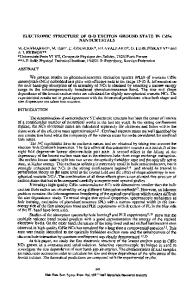Calculation of the Electronic Structure of Silicon Nanocrystals
- PDF / 288,892 Bytes
- 6 Pages / 414.72 x 648 pts Page_size
- 75 Downloads / 273 Views
Abstract The densities of states for Si nanocrystals with diameters between 15 and 35 A. are calculated using a time-dependent algorithm within the tight-binding approximation (1]. The calculated effects of surface termination and surface relaxation on the electronic properties of Si are shown. The variation in band-gap with cluster size is calculated for clusters up to 60 A in diameter. 1. INTRODUCTION Nanometer-sized silicon structures photoluminesce efficiently in the visible part of the spectrum[2]. This observation has prompted many theoretical[3] and experimental[4] studies, both exploring technological applications, and investigating the fundamental physical and electronic properties. The mechanism for the photoluminescence is still not clearly understood. Recently, the synthesis of size-selective Si nanocrystals[5] has been achieved, which has allowed changes in band structure with the extent of spatial confinement to be measured systematically. In this paper we complement these experiments with a theoretical investigation of the electronic properties of Si nanocrystals. This paper is organized as follows. Section 2 describes the theoretical technique used in our calculations. Section 3 illustrates the effect of surface termination on the cluster electronic structure. The calculated variation in band gap with cluster size is discussed in Section 4. Our on-going work is described in Section 5.
2. THEORETICAL TECHNIQUE Recent theoretical studies have employed a number of different techniques including density functional theory, pseudopotentials and tight-binding calculations[3]. We have developed a time-dependent tight-binding method[l] which has two significant advantages over conventional tight-binding methods. First, the size of the cluster is less restricted by computer memory limitations than in methods which diagonalize the Hamiltonian matrix directly. We can calculate the electronic properties of clusters containing up to 106 atoms, whereas other techniques are restricted to around 2,000 atoms. Second, the method can be extended to study excitonic states directly, allowing excited state properties such as absorption energies to be predicted accurately. Other workers have either dealt with the electron-hole interaction perturbatively, or used the effective mass approximation. Work on excited-state calculations is in progress. The technique is summarized below, and is described more completely in Ref. [1].
25 Mat. Res. Soc. Symp. Proc. Vol. 358 0 1995 Materials Research Society
Time-evolution of the electronic wavefunction, T, is calculated using the time-dependent Schr6dinger equation with a tight-binding Hamiltonian W-. ,l(t) = e-"¢,q(O)
(1)
The tight-binding parameters are obtained by fitting to the symmetry points of the bulk band structure using a basis of five atomic orbitals on each atom[6]. Hiickel parameters between the semiconductor surface atoms and additional ligand atoms are used to simulate ligands attached to the cluster surface. The parameters for the cluster-ligand interactions are
Data Loading...

